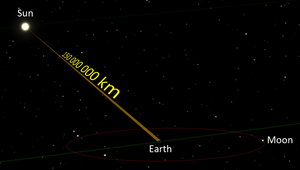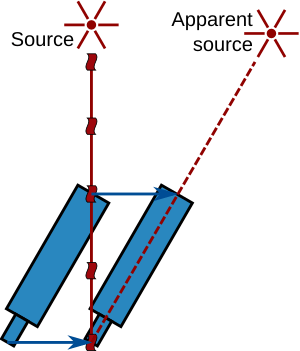Speed of light facts for kids
| Exact values | |
|---|---|
| Planck length per Planck time (i.e., Planck units) |
1 |
| Approximate values (to three significant digits) | |
| Approximate light signal travel times | |
| Distance | Time |
| one foot | 1.0 ns |
| one metre | 3.3 ns |
| from geostationary orbit to Earth | 119 ms |
| the length of Earth's equator | 134 ms |
| from Moon to Earth | 1.3 s |
| from Sun to Earth (1 AU) | 8.3 min |
| one light year | 1.0 year |
| one parsec | 3.26 years |
| from nearest star to Sun 1.3 pc | 4.2 years |
| from the Andromeda Galaxy to Earth | 2.5 million years |
| from Earth to the edge of the observable universe | 46.5 billion years |
The speed of light is how fast light travels through empty space. It's a special number in physics because it's always the same everywhere in empty space. It never changes! Scientists use the letter c to stand for the speed of light.
Light travels incredibly fast. It moves at 299,792,458 meters every second. That's about 186,282 miles per second! Imagine a tiny particle of light, called a photon. It zooms through empty space at this amazing speed.
According to special relativity, a big idea in physics, nothing can go faster than the speed of light. This includes anything with mass, like you or a spaceship. It also includes information and all kinds of energy. Light and other electromagnetic radiation (like radio waves) travel at this speed in a vacuum. Even gravity is thought to travel at this speed.
One of the coolest things about the speed of light is that it doesn't matter if you are moving or standing still. If you measure the speed of light, you will always get the same answer. This idea was a huge discovery by Albert Einstein. It completely changed how we understand space and time. It also led to the famous equation E = mc2, which shows that mass and energy are related.
Contents
How Light's Speed Is Different
Let's think about how light's speed is different from everyday speeds.
Imagine your friend George is standing by train tracks. A train rushes by at 30 miles per hour (mph). George throws a baseball at 90 mph in the same direction the train is moving.
Now, imagine your friend Tom is on the train. Tom has a device to measure how fast the baseball is going. Since Tom is already moving at 30 mph with the train, he measures the baseball's speed as only 60 mph. The speed of the baseball depends on how fast Tom is moving.
Now, let's try the same idea with light. George has a flashlight instead of a baseball.
George is still by the tracks. The train is rushing by at one-third the speed of light. George flashes a light beam in the direction the train is moving. George measures the speed of light as 186,000 miles per second.
Tom, on the train, also measures the speed of the light beam. What speed do you think Tom measures?
You might guess that Tom would measure a slower speed, like two-thirds of the speed George measured. But that's not what happens! Tom measures the exact same speed: 186,000 miles per second.
This might sound impossible, but it's true! Light is a form of energy, and it behaves very differently from solid objects like a baseball. This strange but true fact is a key part of how our universe works.
Scientists like Michael Faraday and James Clerk Maxwell helped us understand that light is an electromagnetic wave. This means it's a way that energy moves through space.
Because nothing can go faster than light, it sets a speed limit for everything in the universe. If an object has mass, no matter how much energy you use to make it go faster, it will get closer and closer to the speed of light, but it will never quite reach it.
When light travels through a clear material, like water or glass, it slows down. The index of refraction tells us how much slower light travels in that material compared to empty space.
Measuring the Speed of Light
Scientists have found clever ways to measure the speed of light over hundreds of years.
Rømer's Early Measurement
Ole Christensen Rømer was a Danish astronomer. In the 1600s, he made the first good guess at the speed of light. He watched Jupiter's moon Io. Io orbits Jupiter, and sometimes it disappears behind the planet (this is called an occultation).
Rømer noticed something interesting. The times when Io disappeared seemed to be a bit off. They were shorter when Earth was moving closer to Jupiter. They were longer when Earth was moving away.
He realized this was because light takes time to travel. When Earth was farther from Jupiter, the light from Io had to travel a longer distance to reach us. Rømer used this idea to figure out that light takes about 22 minutes to cross the entire diameter of Earth's orbit around the Sun. This was a huge step!
Bradley's Method
In the 1700s, James Bradley found another way to measure light's speed. He used something called the aberration of light. Imagine you are running in the rain. Even if the rain is falling straight down, it looks like it's coming at you from an angle. This is because you are moving.
The same thing happens with starlight. As Earth moves around the Sun, our telescopes are moving too. So, the light from distant stars seems to come from a slightly different direction. This makes the stars appear to shift their positions a tiny bit throughout the year.
Bradley used these tiny shifts to calculate how fast light travels compared to Earth's speed around the Sun. He figured out that light travels about 10,210 times faster than Earth in its orbit. This meant light takes about 8 minutes and 12 seconds to travel from the Sun to Earth.
Modern Measurements
Today, scientists use very precise methods to measure the speed of light. They send radio signals to spacecraft far out in our Solar System. By timing how long it takes for these signals to reach the spacecraft and come back, they can calculate the distance.
They combine many of these measurements to get a super accurate value. The speed of light is so important that it's used to define how long a metre is! A metre is officially the distance light travels in a very specific amount of time.
Why the Speed of Light Matters
The speed of light has some big effects on our lives and on space travel.
- Space Travel: If you wanted to travel to the other side of our Milky Way galaxy, it would take a message and its reply about 200,000 years! Even worse, no spaceship can ever go faster than light. This means that traveling across galaxies would take much longer than any human civilization has ever existed. It makes galactic travel very difficult.
- Computers: Even over short distances, the speed of light is important. In powerful supercomputers, information needs to travel between different parts very quickly. A signal can only travel about 30 centimeters (about a foot) in one tiny moment of time (one gigahertz cycle). This means that the parts of a computer must be placed very close together. If computers keep getting faster, the speed of light will eventually limit how small and fast they can be built.
Related pages
Images for kids
See also
 In Spanish: Velocidad de la luz para niños
In Spanish: Velocidad de la luz para niños







